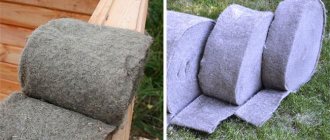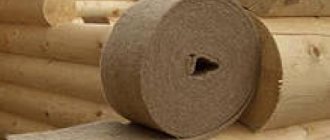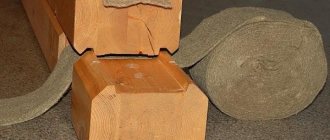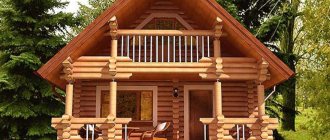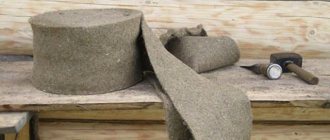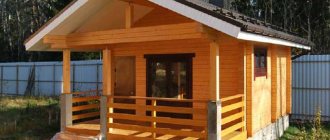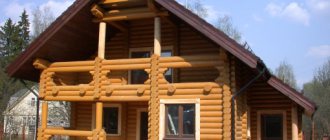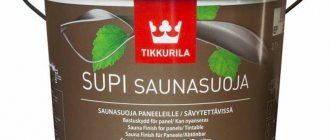Good day to everyone who decided to look at my blog!
Since ancient times, wooden buildings have been insulated with caulk. That is, natural material was pushed between the logs (there is an article about this in more detail). It is worth mentioning that current insulation materials have gone far ahead in terms of practicality. Therefore, today we will try to figure out which inter-crown insulation to choose for timber and logs? Let's look at the different types. And natural, and partially natural, and synthetic. Go!
Of course, wood as a material has many advantages. However, it is necessary to insulate the crowns. If the insulation is installed or selected incorrectly, it will not become one with the wood and the valuable properties of the wood will not manifest themselves well.
Types of interventional insulation
To begin with, let's divide all the material into two types: natural and artificial.
It should be noted that cotton and wool are not suitable for inter-crown insulation of a house or bathhouse. They have one common drawback. Did you guess it? They absorb moisture well and do not release moisture well. They are also “respected” by insects and birds.
What do you need to know about the density of insulation? By the way, every self-respecting manufacturer indicates this parameter. And it should be:
- For houses made of laminated veneer lumber: in the range from 300 to 400 g/m. sq., with a thickness of 4-6 mm.
- For rounded logs : - from 450 to 550 g/m. sq., with a thickness of 8-12 mm;
- For profiled timber: - from 250 to 350 g/m. sq., with a thickness of 2-3 mm;
If the wood has an uneven surface, the sealant should be thicker.
So, what natural options are most suitable for the construction of wooden houses or baths? This is tow made of flax, jute or hemp; long-fiber moss and non-woven felt. Now about these components in more detail:
Let's start with forest moss
- Absorbs water well and dries quickly after rain;
- He is not revered by insects;
- And also, it practically does not rot from moisture.
- In the heat it dries out, turning into dust;
- In case of fire, it lights up before the tree;
- It is difficult to achieve an even installation.
“Not all moss is suitable. The following types are commonly used: red flax, sphagnum moss and cuckoo flax.”
Kukushkin flax
We are building a bathhouse
When laying moss, you need to leave a fringe (as in the photo), which is subsequently pushed into the gap with a special tool with the help of an experienced specialist, that is, you. And a year later (after the log house shrinks), the moss needs to be inspected: where it needs to be knocked down, and where it needs to be trimmed...
Tow
- Absorbs quickly and dries quickly;
- Does not cause allergies and is not static;
- You can make bundles of different lengths and shapes;
- Low cost compared to others.
- Difficulty in laying evenly;
- It is taken away by birds for nests and rots;
- A year later (after shrinkage), the log or timber house is caulked again.
“This material is waste from the initial processing of certain types of plants. It contains cellulose, lignin, pectin and a little wax.”
Jute
Photo: jute tape for caulking a log house, bathhouse and jute rope - intended for finishing the space between the logs - the inter-log seam.
The most popular natural sealant due to the ability to use it to give a variety of inter-crown cracks an attractive appearance. The jute seal is made from purified fibers of the tree of the same name, as a result of which the cord made from this material has excellent strength. Jute trees grow in water throughout Southeast Asia. This explains its excellent resistance to high moisture.
Advantages of jute
Thanks to these unique properties, the sealant made from it is very popular for caulking various inter-crown cracks. By well concentrating moisture in the inter-crown space, jute uniquely prevents the creation of favorable conditions for the formation and growth of colonies of mold, fungi, and destructive bacteria. The dense structure allows you to create a reliable insulating barrier, preventing the penetration of unfavorable atmospheric factors over a long period. The unique ability of jute not to deteriorate under prolonged exposure to high temperatures and high moisture promotes its use as a decorative frame for various cracks in the inter-crown zone of a log house.
Modern natural materials
Jute fabric
- Easy installation. Rolls out on a beam or log;
- Uniformity. Uniform stripe;
- Doesn't puff up from under the crowns;
- Durability of consumer properties;
- Hygroscopicity;
- Impeccable environmental friendliness. There are no harmful additives;
- Economical. No double caulking required.
A jute product is perhaps one of the best in terms of price-quality ratio.
Available in several sizes. Width varies from 2 to 100 cm, thickness from 4 to 12 mm, density ≈700 g/m². You can conveniently and quickly roll it out directly into the groove, securing it with a stapler along the way. After laying, the jute fabric is compacted and becomes resistant to moisture and wind. Excellent for timber. The seam looks symmetrical, and its golden hue harmonizes pleasantly with the color of the wood.
“Jute fabric is practical for a bathhouse, since its fibers remove moisture well.”
Where is it used?
Natural insulation is widely used in the construction of houses. The material fills the inter-crown space. It is often called “inter-crown jute” (“crowns” is the traditional name for wall logs). For installation, a piece of suitable size is torn off from the tape.
Jute insulation is used for wooden structures - bathhouses, log houses and houses made of timber. It is highly effective in terms of thermal protection, does not change the properties of wood and protects it from biological destruction.
Due to the content of resinous substances, jute is resistant to moisture and has antibacterial and antifungal properties.
Lnovatin
Depending on the manufacturing technology, it may be called differently. Refers to quilted fabric (made using the needle-stitching method).
- Good hygroscopicity;
- Easy to install;
- Prevents fungal activity;
- Good sound insulator;
- Environmental friendliness;
- Cost-effective;
- Almost no re-caulking is required.
- The moth "chicks".
Carefully! When purchasing this product, pay attention to the structure. If you notice very short fibers, trimmings of thread, twine and inclusions of other colors, you know that the material contains recycled products. For example, recycled bags, rags, etc. This is not entirely good. Such insulation will be fragile. And besides, it is unknown under what conditions the processed products were used.
Tow
To make this natural sealant, hemp, jute, and flax are used by entangling their short hairs. The name is given to it taking into account the material that makes up the base. Tow of any composition is sold in bags, bales, and strips. For caulking small cracks, tow is the most suitable sealant.
The dignity of tow
The unique features of any tow base allow you to:
- Provide excellent properties of an insulating barrier that reliably prevents any penetration of draft, cold air, noise
- Natural bactericidal characteristics effectively prevent the formation of fungal and mold colonies and the appearance of wood-destroying bugs
- Form an environmentally friendly insulating layer
- Thanks to its tangled structure, tow does not weather and is destroyed during long-term use.
Synthetic inter-crown insulation
Holofiber
Non-woven material based on polyester fibers.
Main use: as insulation for outerwear and bedding. A type of padding polyester known to us. It is produced in two types: sheets (rolls) and layers (hards), having different hardness and density. The choice in each specific case is determined by the characteristics of the wood.
A particularly valuable quality is elasticity (volume restoration). For example, non-profiled timber does not have grooves, and when it dries seasonally, it curls. When a traditional sealant is used, in such situations gaps form that need to be caulked. In addition, natural insulation materials are pressed and caked under the pressure of the timber. Holofiber, thanks to its elastic regeneration, ensures effective filling of cavities.
- Excellent hygroscopicity and elasticity;
- Insects do not live in it and birds do not use it;
- Not allergenic;
- Excellent heat and sound insulation performance;
- Durable;
- Not flammable;
- Does not require re-caulking.
- Not of natural origin;
- Possibility of rotting damp wood.
The material is now produced in Russia, in Moscow.
Polytherm
In a sense, this is a type of Holofiber.
Polyterm is sold in the form of a tape: width: from 30 to 250 mm; has a thickness of 8 - 20 mm; recovers after compression by 90%; golden beige color. All parameters and characteristics are similar to holofiber, so we will not list them.
For a somewhat simplified understanding, I will provide a comparative table. Here we compare many parameters of the usual jute and polythermal intervention tape.
| Name | Jute (ribbon) | POLYTERM (tape) |
| Is re-caulking necessary after the house shrinks? | Yes | No |
| Recoverability after full compression, % | 20 % | 90 % |
| Absorbency at 100% air humidity | Up to 25% | 0% |
| Susceptibility to gradual rotting | Yes | No |
| Hygroscopicity (vapor permeability) | weak | high |
| Operational life (years) | 10 years | 50 years |
| Reuse | Yes | No |
However, there is one thing, but... Polytherm is a relatively new material and we do not know the long history (at least more than 10 years) of its use. Therefore, an objective analysis of its capabilities can be done in a few years. In the meantime, Polyterm suppliers can say whatever they want!
Now, my personal reviews. Having worked with similar materials for many years, I will say the following: you will not find a better and more practical “jute wheel”. Tested in practice! The same thing, my builder friends can confirm. Maybe we just don’t want to recognize synthetics?!
Video description
The correct use of seam sealants is shown in this video:
But the first caulk is not the only one, especially when it comes to natural insulation. The logs in a wooden frame shift and rub against each other; this period can take up to 3 years, during which the walls will have to be additionally caulked. But even after shrinking, the insulation can fall out and become unusable, so it needs to be replaced as it wears out. The tools for re-caulking a log house are the same as for the first one.
Repeated caulking occurs as many times as necessary. This is a targeted procedure that corrects the situation only in the place where new cracks have appeared. It is advisable to perform it in the fall before the rains begin. Even if the shrinkage should have ended long ago, you need to inspect the house annually and update the caulk.
Final Recommendation
By the way, recently (on the eve of the New Year) a fellow colleague of mine bought flax-jute fabric at. He liked the conversation with the consultant (in his words, he understands issues of wooden house construction very well) and the price of the product was quite reasonable. This is not an advertisement - just a consultation, which is always useful. I recommend this company for residents of Moscow and the Moscow region. Moreover, the company is specialized and has been on the construction market for several years.
Well, perhaps he said everything he wanted. If it was informative, then do not miss the release of new information. Do you have friends who are building a bathhouse or a house? Recommend the article to them.
Good luck and warm, well-caulked walls. Bye!
Quote of wisdom: This is how men are made: they can resist the smartest arguments and cannot resist a single glance (Bazzak).
The best option
The experience of professional builders shows that the optimal solution in terms of price/quality is a combined option - flax-jute or jute felt with admixtures of flax (sometimes other components). Jute gives the structure the necessary rigidity, and flax gives elasticity and elasticity. The ratio can be 10/90 or 50/50.
There are standards for using flax jute for different types of timber:
- For example, for a beam 150 by 150 mm, the width of the jute insulation should be 152 mm with a thickness of 5-8 mm;
- For chopped logs, wider felt with a width of 100-150 mm is used. In the case of a rare log house with a thickness of 250 mm and above, you can find strips of a similar width. For example, on the website of one jute manufacturer it is stated that, if necessary, you can cut ribbons up to 1600 mm wide.
How to make calculations
In order to calculate how much material is required to insulate your home, you need to follow certain rules. First, we determine the density of the insulating material, which depends on its weight, length and width. Determining these parameters will not be difficult, since the weight can be found out by weighing the material, and you know the width and length already upon purchase on the price tag.
Next you need to enter this data into the formula and calculate the result. It is known that density is directly proportional to weight, expressed in grams, and inversely proportional to the width and length of the material, expressed in meters. As a result, the resulting indicator should coincide with what is indicated by the seller (or manufacturer).
Example:
- if the thickness is 0.5 cm, then the density should be 400 g/m2;
- if the thickness is 0.8-1 cm, then the density is about 600 g/m2;
- if the thickness is 1.5 cm, then the density is about 800 g/m2.
What are the conclusions?
Lush insulation is not an indicator of quality. It is better to take insulation made using modern technologies
Adding flax to jute tape reduces the cost, but at the same time reduces the quality. The material becomes more susceptible to moth eating and rotting.
Do-it-yourself finishing caulk
After the log house has been subjected to shrinkage, finishing caulking is carried out at home. During the shrinkage process, the previously laid layer of insulation is deformed, voids can form in the inter-crown cracks, and vertical cracks can form in the corners of the frame. The operation is performed from the outside and inside. Caulking is a labor-intensive process that requires diligence and attention; the main tool is a wide wooden chisel or rubber mallet. To avoid damaging the integrity of the fibers, it is better to blunt the chisel. The operation begins with the lower crown along the entire perimeter, after caulking of the first crown is completed, they move on to the second, etc.
Requirements for an ideal interventional heat insulator for a log bathhouse
In addition to the maximum possible coefficient of thermal resistance, inter-crown insulation for a bathhouse must:
- Have moderate vapor permeability. The temperature and humidity in the steam room fluctuate intensely. The ability of a heat insulator to accumulate and evaporate moisture should be comparable to that of wood. Only then will it be possible to avoid condensation of liquid between the crowns, which contributes to the development of bacterial and fungal flora.
- Demonstrate volume recovery after removal of the load. For a log house in which a steam room is installed, it is doubly important to compensate for the cyclic change in the gaps between the beams. Indeed, here, in addition to natural shrinkage and the change of seasons, the wood is affected by extreme changes in humidity, which contribute to the expansion and contraction of logs. Only inter-crown insulation with good residual elasticity is capable of filling gaps of varying sizes.
- Contain antiseptics and/or other substances that resist the formation of mold and rot.
- Be distinguished by biological resistance and stability of properties. That is, to be “uninteresting” for birds and insects, and also not to become brittle and lose integrity under the influence of temperature, humidity and solar radiation.
- Be moderate in price and easy to use. You don’t expect to spend 30% or 40% of the budget of the entire building on purchasing insulation for inter-crown joints, do you?
- Harmonize with the aesthetics of the log house.
- Be an environmentally friendly material.
Which one is better to choose?
From all of the above, we can conclude that for façade installation it is better to purchase ecowool, mineral wool, and basalt fiber:
- A well-known manufacturer of the first material in Russia is Ekovata Extra LLC. Its cost is 1,115 rubles per m3.
- To seal the seams, it is better to use tow or hemp. Reliable products are considered to be material from Kuzmin's Linen Manufactory LLC "Len&Jute", where you can purchase tow. The cost of 30 kg of product in bales is 1,800 rubles.
- For interior work, it is better to use polyurethane foam or acrylic sealant. The Russian company is engaged in the production of polyurethane foam. A kilogram jar of the product costs 312 rubles.
"Ancient" methods of insulation
You can also use simpler and long-used options. For example, use moss as insulation. Many species of this plant grow in nature, but only two varieties are best suited for insulating a wooden house:
- sphagnum - has a large amount of antiseptic substances. This feature allows you to reliably protect your home from the harmful effects of the environment;
- Kukushkin flax has less antiseptic effect. This moss is not laid completely dry, so its thermal insulation properties will be better.
Such insulation will help create a better microclimate in your home. This is created due to the aroma of the forest that the material emits. There will always be a pleasant atmosphere in your home.
Ordinary moss - sphagnum - can be used as inter-crown insulation.
The moss itself is environmentally friendly and does not cause allergies. But assembling it yourself is quite difficult. Moss grows in swamps and other damp places. In addition, each variety requires its own technology for collection and preparation for use. It is quite difficult to prepare it in the required quantities yourself, so this method of insulating the inter-crown space is rarely used today.
For your home, you can choose a simple tow. This material is made from various raw materials, it can be flax or hemp. But such insulation has one “bad” property: birds really like it. The fibers are easily separated from the main mass, which forces the seams to be repaired annually. In addition, tow absorbs moisture well and can rot.
Popular manufacturers and prices
On sale inter-crown insulation made from natural plant fibers are represented by the following brands: “Thermo-Hanf”, “Val-Flax”, “ThermoLen” (“ThermoJUT”), “Flaxan”, “Ekoteplin”, “Ecoterm”, “Ekolen”, etc. ., both Russian-made and European manufacturers. More detailed information about them is given in the work: “Review of flax insulation.”
Let us separately note the prices. So, for 1 linear m with a thickness of 5 mm, a width of 15 cm and a density of 450 g/m2 must be laid out for products from:
- flax - 11 rubles;
- jute - 13 rubles;
- jute mixed with flax - 12 rubles.
With changes in thickness and width, as well as density, prices also change.
Synthetic insulation is produced by:
- "Holofiber" - enterprise "Thermopol" (Moscow);
- "Polytherm" is a center for inter-crown insulation (Moscow).
For comparison, we present the price per 1 linear meter. the same parameters as natural fibers - 32.7-43.6 rubles.
